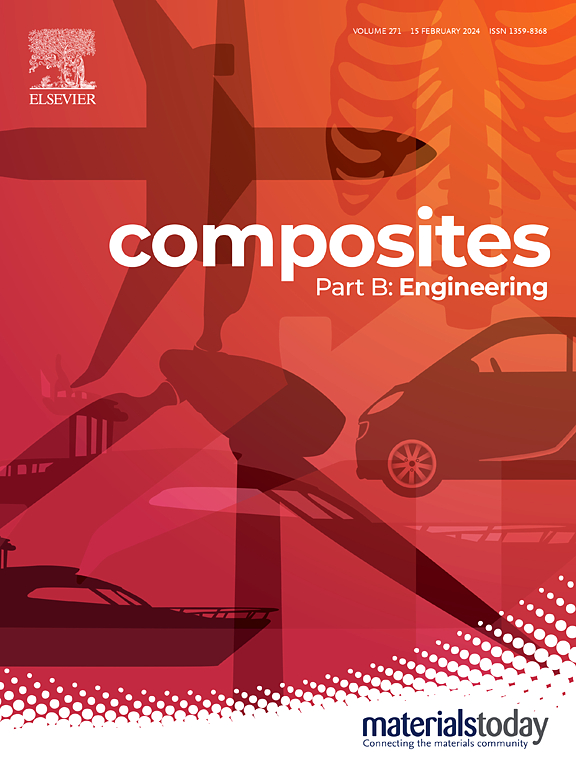Self-adaptive thermal interface materials featuring low thermal resistance by combining phase change materials with magnetic field-induced filler alignment
IF 12.7
1区 材料科学
Q1 ENGINEERING, MULTIDISCIPLINARY
引用次数: 0
Abstract
Thermal interface materials (TIMs) with high thermal conductivity, low thermal resistance, and adaptive capabilities are urgently needed to address the heat dissipation challenges posed by miniaturized electronic devices. However, achieving high through-plane conductivity remains challenging due to difficulties in constructing effective thermal pathways through the thickness of the composite. Furthermore, the mechanical properties of TIMs, which are crucial for enhancing heat dissipation by minimizing contact thermal resistance, are frequently overlooked. Herein, mesophase pitch-based carbon fibers (CFs) at a relatively low content (16 wt%) are vertically aligned in polyethylene glycol (PEG) under a minimal magnetic field (∼0.7 T), resulting in vertically aligned CFs/PEG (VACFs/PEG) composite with an impressive thermal conductivity of 24.24 W/m·K. This composite achieved a temperature reduction of 8.1°C for a LED of 30 W. In addition, the PEG matrix demonstrates adaptive properties at increasing temperatures, contributing to a reduction in thermal resistance to 1.12 cm2 K/W. Furthermore, the VACFs/PEG composite exhibits a latent heat of fusion of 118.03 J/g, demonstrating excellent short-term thermal storage performance and promising potential for use in complex thermal management system.
结合相变材料和磁场感应填料排列的低热阻自适应热界面材料
为了解决电子器件小型化带来的散热挑战,迫切需要具有高导热性、低热阻和自适应能力的热界面材料。然而,由于难以通过复合材料的厚度构建有效的热通道,实现高通平面导电性仍然具有挑战性。此外,TIMs的机械性能是通过最小化接触热阻来增强散热的关键,但经常被忽视。本文中,相对低含量(16 wt%)的中间相沥青基碳纤维(CFs)在最小磁场(~ 0.7 T)下垂直排列在聚乙二醇(PEG)中,得到垂直排列的CFs/PEG (VACFs/PEG)复合材料,其导热系数为24.24 W/m·K。这种复合材料实现了30 W LED温度降低8.1°C。此外,PEG矩阵在升高的温度下表现出自适应特性,有助于将热阻降低到1.12 cm2 K/W。此外,VACFs/PEG复合材料的熔合潜热为118.03 J/g,具有良好的短期储热性能,在复杂的热管理系统中具有广阔的应用前景。
本文章由计算机程序翻译,如有差异,请以英文原文为准。
求助全文
约1分钟内获得全文
求助全文
来源期刊

Composites Part B: Engineering
工程技术-材料科学:复合
CiteScore
24.40
自引率
11.50%
发文量
784
审稿时长
21 days
期刊介绍:
Composites Part B: Engineering is a journal that publishes impactful research of high quality on composite materials. This research is supported by fundamental mechanics and materials science and engineering approaches. The targeted research can cover a wide range of length scales, ranging from nano to micro and meso, and even to the full product and structure level. The journal specifically focuses on engineering applications that involve high performance composites. These applications can range from low volume and high cost to high volume and low cost composite development.
The main goal of the journal is to provide a platform for the prompt publication of original and high quality research. The emphasis is on design, development, modeling, validation, and manufacturing of engineering details and concepts. The journal welcomes both basic research papers and proposals for review articles. Authors are encouraged to address challenges across various application areas. These areas include, but are not limited to, aerospace, automotive, and other surface transportation. The journal also covers energy-related applications, with a focus on renewable energy. Other application areas include infrastructure, off-shore and maritime projects, health care technology, and recreational products.
 求助内容:
求助内容: 应助结果提醒方式:
应助结果提醒方式:


